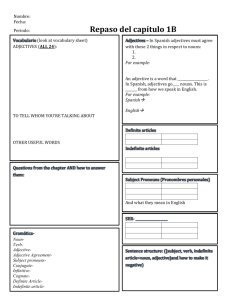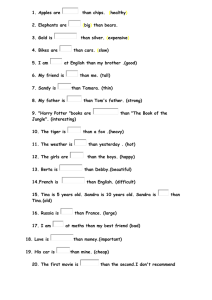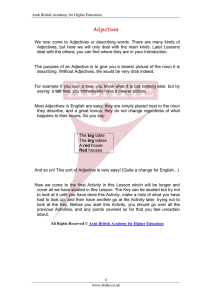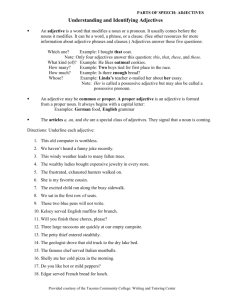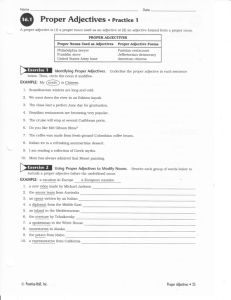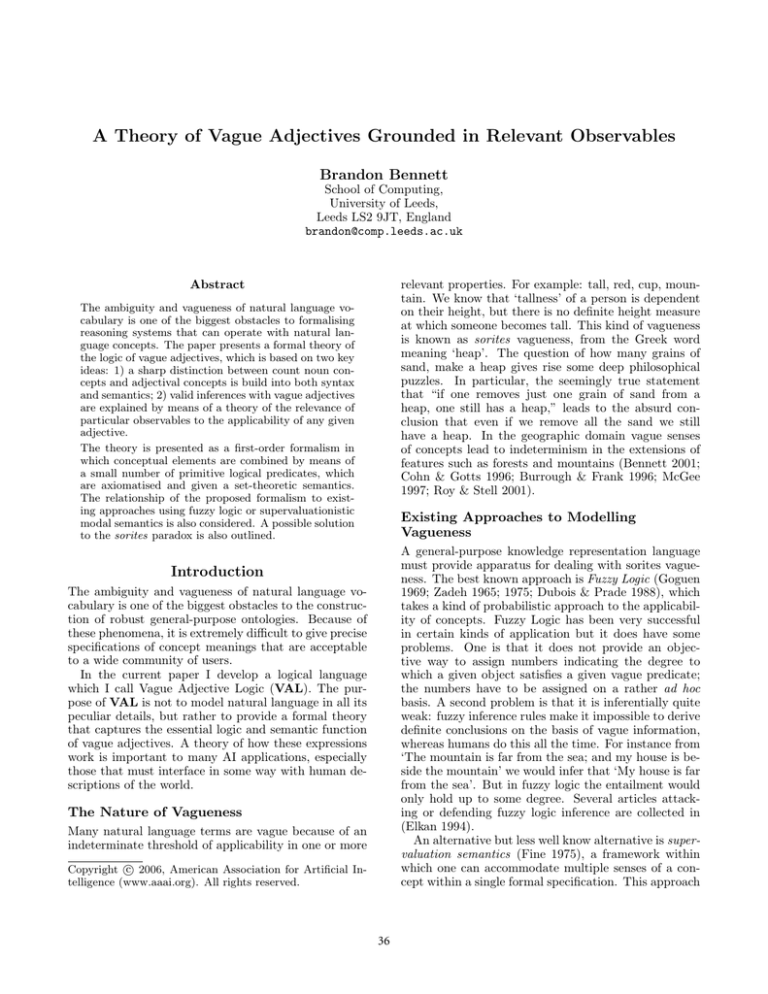
A Theory of Vague Adjectives Grounded in Relevant Observables
Brandon Bennett
School of Computing,
University of Leeds,
Leeds LS2 9JT, England
brandon@comp.leeds.ac.uk
relevant properties. For example: tall, red, cup, mountain. We know that ‘tallness’ of a person is dependent
on their height, but there is no definite height measure
at which someone becomes tall. This kind of vagueness
is known as sorites vagueness, from the Greek word
meaning ‘heap’. The question of how many grains of
sand, make a heap gives rise some deep philosophical
puzzles. In particular, the seemingly true statement
that “if one removes just one grain of sand from a
heap, one still has a heap,” leads to the absurd conclusion that even if we remove all the sand we still
have a heap. In the geographic domain vague senses
of concepts lead to indeterminism in the extensions of
features such as forests and mountains (Bennett 2001;
Cohn & Gotts 1996; Burrough & Frank 1996; McGee
1997; Roy & Stell 2001).
Abstract
The ambiguity and vagueness of natural language vocabulary is one of the biggest obstacles to formalising
reasoning systems that can operate with natural language concepts. The paper presents a formal theory of
the logic of vague adjectives, which is based on two key
ideas: 1) a sharp distinction between count noun concepts and adjectival concepts is build into both syntax
and semantics; 2) valid inferences with vague adjectives
are explained by means of a theory of the relevance of
particular observables to the applicability of any given
adjective.
The theory is presented as a first-order formalism in
which conceptual elements are combined by means of
a small number of primitive logical predicates, which
are axiomatised and given a set-theoretic semantics.
The relationship of the proposed formalism to existing approaches using fuzzy logic or supervaluationistic
modal semantics is also considered. A possible solution
to the sorites paradox is also outlined.
Existing Approaches to Modelling
Vagueness
A general-purpose knowledge representation language
must provide apparatus for dealing with sorites vagueness. The best known approach is Fuzzy Logic (Goguen
1969; Zadeh 1965; 1975; Dubois & Prade 1988), which
takes a kind of probabilistic approach to the applicability of concepts. Fuzzy Logic has been very successful
in certain kinds of application but it does have some
problems. One is that it does not provide an objective way to assign numbers indicating the degree to
which a given object satisfies a given vague predicate;
the numbers have to be assigned on a rather ad hoc
basis. A second problem is that it is inferentially quite
weak: fuzzy inference rules make it impossible to derive
definite conclusions on the basis of vague information,
whereas humans do this all the time. For instance from
‘The mountain is far from the sea; and my house is beside the mountain’ we would infer that ‘My house is far
from the sea’. But in fuzzy logic the entailment would
only hold up to some degree. Several articles attacking or defending fuzzy logic inference are collected in
(Elkan 1994).
An alternative but less well know alternative is supervaluation semantics (Fine 1975), a framework within
which one can accommodate multiple senses of a concept within a single formal specification. This approach
Introduction
The ambiguity and vagueness of natural language vocabulary is one of the biggest obstacles to the construction of robust general-purpose ontologies. Because of
these phenomena, it is extremely difficult to give precise
specifications of concept meanings that are acceptable
to a wide community of users.
In the current paper I develop a logical language
which I call Vague Adjective Logic (VAL). The purpose of VAL is not to model natural language in all its
peculiar details, but rather to provide a formal theory
that captures the essential logic and semantic function
of vague adjectives. A theory of how these expressions
work is important to many AI applications, especially
those that must interface in some way with human descriptions of the world.
The Nature of Vagueness
Many natural language terms are vague because of an
indeterminate threshold of applicability in one or more
c 2006, American Association for Artificial InCopyright telligence (www.aaai.org). All rights reserved.
36
Contextual Relativity of Vague Adjectives
also enables one to specify logical constraints which apply either to all senses or to a restricted range of senses
of a concept. One way of bringing the semantical richness of supervaluation semantics into the object language is to employ a modal logic (Bennett 1998).
Semantic approaches of this kind have so far been
little applied to Knowledge Representation for AI. Notable exceptions are (Bennett 2002), which considers
how vagueness affects the identity conditions of physical objects and (Halpern 2004) which considers how
vagueness affects perceptual observations of continuously varying properties.
A widely recognised problem that affects many vague
adjectives is that the criteria for their ascription may
strongly depend upon the type of thing to which they
are applied. For instance a ‘large man’ may be much
smaller in absolute terms than a ‘large elephant’ (or
even a relatively small elephant). Because of this we
cannot simply treat both adjectives and count nouns
as predicates. Hence, the present theory incorporates
explicit representation of the combination of adjectives
with count nouns.
Although dependence on count nouns is a key feature
of many uses of vague adjectives, there are also types of
proposition where properties of different kinds of thing
are compared in an absolute way. For example, we may
say that ‘This elephant is taller than that man’. In such
a case we do not normally relativise the idea of tallness
to the different types of animal involved. The formal
language presented here also supports representation of
assertions involving this kind of absolute comparison.
Parameterised Meanings and Relevant
Observables
Supervaluation theory can be seen as modelling sorites
vague concepts as having a meaning that varies according to one or more parameters, whose values are not
specifically stated. In a given context, assertions which
involve semantically related concepts are taken as sharing the same parameter-space and hence varying in a
mutually consistent way. Valid inference can then be
modelled in terms of entailments that hold whatever
the choice of these underlying indeterminate parameters. A fundamental idea of the proposed theory is
that the ascription of a vague adjective a judgement
that sets arbitrary thresholds for a number of relevant
objective measures.
Within any given context I assume that a language
user employs a choice of thresholds that is consistent
across usages of all concepts. Thus, where two or more
concepts have some semantic interdependence, this will
be maintained by consistent usage of thresholds. For
example ‘tall’ and ‘short’ are (in a particular context)
mutually exclusive and are dependent on the objective
observable of height. Thus the height threshold above
which a person to be considered ’tall’ must be greater
than the height threshold below which a person is considered ’short’. Note that as well as depending on a
particular context in which the terms are used, there is
also an explicit dependence of these thresholds on the
type of thing to which the terms are applied; i.e. in this
example they are applied to a person.
To describe the collection of threshold values that affect a judgement involving vague concepts, I adopt the
word standpoint as a theoretical term. A standpoint is a
semantic object associated with a complete assignment
of threshold values to parameters associated with the
vague vocabulary of a formal language. Standpoints,
can be regarded as indices relative to which a vague
assertion is interpreted. Thus, they are similar to the
possible worlds in Kripke semantics for modal logics. In
fact they can be seen as an elaboration of the idea of
a precisification that is often taken as indexing propositions in supervaluation semantics. The difference is
that standpoints have an internal structure, which explicitly describes the dependence vague propositions on
a particular choice of threshold judgements.
Overview of VAL Syntax
Count Nouns and Adjectives
Although the language that will be presented is essentially a variant of first-order logic, it does have quite
significant differences in its syntax. In particular, I
make a clear syntactic distinction between count nouns
(‘woman’, ‘giraffe’, ‘table’, ‘pen’, etc.) and adjectives
(‘tall’, ‘happy’, ‘heavy’, etc.). In the following paragraphs I will explain why this distinction is necessary.
In my opinion, treating these two types of concept as
essentially the same is a fundamental shortcoming in
the way that logical languages have been applied to
modelling natural language concepts.
In standard first-order logic, both count nouns
and adjectives are treated as predicates.
Thus,
‘Jane is a tall woman’ would be represented by
something line Tall(jane) ∧ Woman(jane). and similarly ‘Gerald is a tall giraffe’ would be written as
Tall(gerald ) ∧ Giraffe(gerald ). But this leads to a problem: ‘Tall’ being a predicate will, in the usual first-order
semantics, correspond to a set of objects. In order for
both of these propositions to be true, both Jane and
Gerald must be members of the set of ‘tall things’. But
of course even a small giraffe will be much taller than
a tall woman. Thus, the criterion for membership of
the set of tall things cannot depend merely on height,
it must also depend on the type of thing in question
— in other words, it will depend on the count noun
of which the object is an instance. But the difficulty
comes when we realised that any given object can be
considered as an instance of many different count nouns.
For example, Gerald is certainly an animal as well as
a giraffe. Now the real problem comes when we want
to make sense of a statement ‘Gerald is a tall animal
but he is not a tall giraffe’. This cannot be consistently
represented using the standard first-order treatment of
adjectives, since it can only be true if Gerald is both a
37
member of the set of tall things and not a member of
this set.
A solution to this problem can be obtained by treating adjectives not as classical predicates, but rather as
operators modifying the meaning of count nouns. Let a
be a vague adjective and c a category of object (which
would normally correspond to a natural language count
noun). The ascription of a to x, considered as an instance of c can be written as a complex predication of
the form [a ◦ c](x). Here the adjective a is relativised
to the category c. For example ‘John is a tall man’
would be represented as [tall ◦ man](john). This notation indicates the compositional semantics of adjectives.
According to this analysis, the meaning of the adjective operates on the count noun in order to produce
a complex count noun, which is a restricted or otherwise modified version of the original. It is this modified
count noun which is then applied as a predicate to a
named object.
However, for computational manipulation (e.g. use of
theorem provers) it is convenient reduce this notation
to a standard first-order form. In order to do this I reify
both count nouns and adjectives, so that one can write
those that hold to varying degrees for different objects.
The latter may be called graded (or simply vague). The
classical semantics for predicates is well suited to absolute (restrictive) adjectives but provides no mechanism
for interpreting graded adjectives. The focus of this
paper is on adjectives that are restrictive and graded
and these will be specified using the logical predicate
ResGrad(a).
Adjectives and Relevant Observables
A key idea of the present theory is that the use of any
given vague adjective can be explained in terms of a
number (usually a small number) of relevant observables. For example, in deciding whether a person is
‘tall’, the relevant observable is their height. In VAL
the relevance between an observable and an adjective is
formalised as a primitive logical relation. Thus we may
write Rel(height, tall).
In some cases we may want to specify that the applicability of a particular vague adjective depends only
on a single observable. For instance we might state
(∀o)[Rel(o, tall) ↔ (o = height)]. More generally, there
may be a number of observables relevant to a given adjective.
For natural language adjectives it may not always be
completely clear which observables are relevant. This is
because of a deep conceptual ambiguity in certain natural terms. Considering this in detail would go beyond
the scope of the present work. However, there are plenty
of examples where the relevant observables are fairly
clear. And moreover, the formalism presented here will
allow one to do useful reasoning without assuming full
knowledge of all instances of the Rel relation.
Isa(x, a, c) .
For instance, Isa(john, tall, man). Here, the ‘Isa’ predicate is just used to glue the various reified components
together.
Since, count nouns have been reified, their use as
predicates will also need to be modified. Instead of
writing c(x), to mean x is an instance of count noun c,
I write Isa(x, c).
Restrictive vs Non-Restrictive Adjectives The
meaning of most adjectives is such that, when applied
to a count noun, the resulting modified count noun applies to a subset of the objects to which the original
count noun applied. For instance, the set of ‘tall men’
is a subset of the set of ‘men’. These will be called restrictive adjectives, and I will use the logical predicate
Restrictive(a), to assert that adjective ‘a’ is restrictive.
The meaning of this predicate can be defined as follows:
Observables and their Relative Magnitudes
The logic of observables and adjectives will be grounded
by associating each observable o with a relationship describing the relative magnitude of an observable in relation to a pair of individuals. This will be represented by
the primitive relation Obgeq(o, x, y), which states that
individual x exemplifies the observable o to a degree
greater than or equal to individual y.
Thus, for any given observable, the relation
Obgeq(o, x, y) specifies a preorder over the domain of
individuals — i.e. it satisfies the following axioms:
D1) Restrictive(a) ≡def ∀xc[Isa(x, a, c) → Isa(x, c)]
By contrast, non-restrictive adjectives are those such
that Isa(x, a, c) can hold, when Isa(x, c) is not true. For
instance, we can have
Isa(quacky, rubber, duck) ∧ ¬Isa(quacky, duck).
In the current work, the focus is on restrictive adjectives, since these are the ones for which relatively
strong inferential rules hold. However, the distinction
is made explicit so that non-restrictive adjectives can
be employed without fear of incorrect inferences. Inferences involving non-restrictive adjectives would require
special axioms tailored to their specific meanings.
A1) ∀ox[Obgeq(o, x, x)]
A2) ∀oxyz[(Obgeq(o, x, y) ∧ Obgeq(o, y, z)) →
Obgeq(o, x, z)]
For many common observables (those that may be regarded as one dimensional) the corresponding ordering
is total. Hence, I add an auxiliary axiom
A3) ∀oxy[Total(o) →
(Obgeq(o, x, y) ∨ Obgeq(o, y, x))]
It will often be useful to employ the relations asserting that an individual exemplifies an observable to an
equal degree or to a strictly greater degree than another.
Thus I define:
Absolute vs Graded Adjectives A second classification of types of adjectives is the distinction between
those that are either true or false for a given object
(relative to the count noun by which it is referred) and
38
D2) Obeq(o, x, y) ≡def
the other object cannot satisfy the object to at least as
great a degree as the second.1 (This means that the
first object satisfies the adjective to a strictly greater
degree than the second — see definition of More(a, x, y)
below.) A6 requires that if one thing exhibits an adjective to a strictly greater degree than another it must
exhibit at least one relevant observable to a greater degree than the other. Finally A7 imposes the condition
of transitivity on the Atleastas relation.
It should be noted that although these axioms place
tight constraints on the Atleastas relation, in terms of
the relative magnitudes of relevant observables, these
relative magnitudes do not fully determine the extension of Atleastas.
It is easy to define additional relations to express the
condition that one objects exhibits an adjective to a
greater degree than another, or that two objects equally
satisfy the adjective.
Obgeq(o, x, y) ∧ Obgeq(o, y, x)
D3) Obg(o, x, y) ≡def
Obgeq(o, x, y) ∧ ¬Obgeq(o, y, x)
Comparatives An important aspect of the meaning
of adjectives is their relationship to associated comparative relations. Thus, the adjective ‘tall’ is intimately
connected with the comparative ‘taller’. It is interesting to note that even when we are dealing with vague
adjectives, such as ‘tall’, the corresponding comparative
‘taller’ is more or less precise (leaving aside certain possible quibbles about how height should be measured).
Hence, the logic of comparatives is very significant in
reasoning about vague adjectives.
The essence of the theory presented here is that adjectival comparative relations are determined by the orderings of the values of relevant observables. In the case
of adjectives that have just a single relevant observable,
the correspondence is simple, as the comparative is determined directly by the observable ordering. But, more
generally, several observables may be involved. For instance, speed, agility, strength and stamina might all be
considered relevant to being athletic. In such cases we
may have pairs of individuals for which their relative ordering with respect to one relevant observable is opposite to their ordering with respect to another (one person may be faster than another but have less stamina).
Here the adjectival comparative is not straightforwardly
determined by the observables. In terms of abstract semantics, the ordering can be modelled by an arbitrary
compound function of the different observables, satisfying appropriate monotonicity conditions (which will
be specified later in the section on Semantics). These
conditions correspond to axiomatic constraints, which
determine the dependence of the adjectival comparative
relations on the observable orderings, via the relevance
relation, Rel.
The primitive comparative relation of the theory is
Atleastas(a, x, y), which means that object x exemplifies
the adjective a to at least as great a degree as object y.
This relation satisfies the following axioms:
D4) ∀axy[Equally(a, x, y) ↔
(Atleastas(a, x, y) ∧ Atleastas(a, y, x))]
D5) ∀axy[More(a, x, y) ↔
(Atleastas(a, x, y) ∧ ¬Atleastas(a, y, x))]
The ‘More’ relation gives us a convenient means to
define relations that correspond closely to natural language comparatives. For instance,
Taller(x, y) ≡def More(tall, x, y) .
Axioms Relating Adjectives and Comparatives
Now that we have introduced the adjectival comparative relations, we can use these to formulate some key
inferential principles that are used in reasoning about
restrictive graded adjectives.
A8) ∀acxy[(ResGrad(a) ∧ Isa(x, a, c) ∧ Isa(y, c) ∧
Atleastas(a, y, x)) → Isa(y, a, c)]
A9) ∀acxy[(ResGrad(a) ∧ Isa(x, a, c) ∧ Isa(y, c) ∧
¬Isa(y, a, c)) → More(a, x, y)]
Informally A8 says that if object x is considered as
satisfying a given (graded) adjective and a second object y is of the same kind and also satisfies that adjective
to the same or greater degree, then y also satisfies that
adjectives. (Note that the ascription of the adjective
is — as always in this theory — relative to the count
noun under which the objects are described. So the axiom requires that both objects are described in terms
of the same count noun.)
A9 concerns the case where we have two objects
of the same kind and one satisfies a graded adjective,
whereas the other does not. This implies that the first
object exemplifies the adjective to a greater degree than
the second.
A4) ∀axy[∀o[Rel(o, a) → Obgeq(o, x, y)] →
Atleastas(a, x, y)]
A5) ∀axy[(∀o[Rel(o, a) → Obgeq(o, x, y)] ∧
∃o[Rel(o, a) ∧ Obg(o, x, y)]) → ¬Atleastas(a, y, x)]
A6) ∀axy[(Atleastas(a, x, y) ∧ ¬Atleastas(a, y, x)) →
∃o[Rel(o, a) ∧ Obg(o, x, y)]]
A7) ∀axy[(Atleastas(a, x, y) ∧ Atleastas(a, y, z)) →
Atleastas(a, x, z)]
A4 ensures that if an object’s observable values for
all observables relevant to a given adjective are as least
as great the relevant values of another object, then the
first object satisfies the adjective to at least the same degree as the second. A5 ensures that if an object’s relevant observables are at least as great as those of another
and in at least one case are greater than the other, then
1
It is possible that one may wish to drop this axiom
in certain cases. For instance if a two objects are equal
in all observables relevant to an adjective apart from small
differences, one may wish to allow them to be considered as
equally exemplifying the adjective.
39
Converse Observables Adjectives often come in
pairs of polar opposites (e.g. ‘tall’ and ‘short’). Here
the same observable(s) is (are) relevant to both adjectives; however, the sense in which the magnitude of the
observable(s) contributes to the justification for ascribing the adjective is reversed. Thus to state semantic
relationships between adjectives we will often want to
refer to this converse relationship. The converse of an
observable is expressed by the function conv(x).2 Thus
we can write
conv(tall) = short .
or Isa(john, quite(clever), man). The very operation is
governed by the following axioms:
A14) ∀acx[Isa(x, very(a), c) → Isa(x, a, c)]
A15) ∀acxy[(ResGrad(a) ∧ Isa(x, very(a), c) ∧
Isa(y, c) ∧ ¬Isa(y, very(a), c)) → More(a, x, y)]
The natural language modifier ‘quite’ is somewhat
more subtle and seems to be ambiguous. For instance
‘John is quite tall’ could be interpreted as meaning either:
• John is not really ‘tall’ although he is almost high
enough to be ‘tall’;
• John is tall but not very tall;
The converse relationship between adjectives corresponds to an analogous relationship between observables. Hence, I overload the conv function an allow it
to also operate on observables; so that conv(flexibility)
is an observable whose order relation is the inverse of
the order relation associated with flexibility. Hence,
we might write
or it could be taken as equivalent to the disjunction of
these two interpretations.
In order to cater for this range of meanings I
first introduce a the adjectival operator als(a), to be
read as ‘at least somewhat’. Thus, the predicate
Isa(x, als(tall), man) is true of any man, x, of at least
somewhat tall stature.
conv(flexibility) = rigidity .
When an observable gives rise to an ordering, it seems
that we often have a natural preference to associate a
particular direction to that ordering. For instance, in
ordering objects in terms of their vertical extension,
the natural ordering is in terms of increasing height,
not ‘shortness’. However, for the purpose of formalising the theory, it is much more convenient if all observables have a converse, even if this doesn’t necessarily
correspond to a common natural language term.
The logic of the converse operator is specified by the
following axioms:
A10)
A11)
A12)
A13)
A16) ∀acx[Isa(x, a, c) → Isa(x, als(a), c)]
A17) ∀acxy[(ResGrad(a) ∧ Isa(x, als(a), c) ∧
Isa(y, c) ∧ ¬Isa(y, als(a), c)) → More(a, x, y)]
Although als does not itself correspond to a basic
adjectival modifier of natural language, it does enable
one to define modifiers whose meaning corresponds well
with the different senses of ‘quite’ mentioned above.
Additional Non-Logical Relations As well as representing information relating to vague adjectives and
observables, we may sometimes want to reason with additional relationships between objects. Since the theory
is encoded within ordinary 1st-order logic, we can simply employ any additional predications R(x1 , . . . , xn )
we wish to use.
∀x[conv(conv(x)) = x]
∀oa[Rel(o, a) ↔ Rel(conv(o), conv(a)]
∀axy[Obgeq(a, x, y) → Obgeq(conv(a), y, x)]
∀xac[¬(Isa(x, a, c) ∧ Isa(x, conv(a), c))]
A10 makes the conv function self-inverse. A11
means that the observables relevant to an adjective are
exactly the converse observables of those relevant to
the converse adjective. A12 ensures that converse observables induce opposite orderings on the domain of
objects. From A11, A12 and the axioms for Atleastas
it follows that the Atleastas relation runs in opposite
directions for converse adjectives:
Semantics
Since VAL is formulated within standard 1st-order
logic, it comes already equipped with the standard settheoretic semantics. However, this is a very general
semantics, which does not place any particular structural restrictions on the semantic interpretation of the
fundamental primitives of the VAL theory. To give a
better idea that the theory captures the intuitive meanings of the notions it seeks to formalise, it will be useful
to provide a more specific interpretation, within which
the fundamental primitives (Obgeq(o, x, y), Rel(o, a),
Isa(x, c), Isa(x, c) and Atleastas(a, x, y)) are associated
with semantic structures that capture intuitive properties of their meaning.
I start by considering suitable denotations and structures corresponding to each of the different syntactic
elements of VAL. Following this, I shall combine these
to define formal model structures, which can function
as interpretations of any consistent VAL formula.
∀axy[Atleastas(a, x, y) → Atleastas(conv(a), y, x)]
A13 is a further important axiom, which ensures that
no object can exemplify both an adjective and its converse.
Adjectival Modifiers The proposed language also
enables the modifiers ‘very’ and ‘quite’ to be applied to adjectives as functional operators. Thus we
can write, for example, Isa(gerald , very(tall), giraffe)
2
For theorem proving purposes, it may be better to represent converses by means of a symmetric binary relation,
Conv(a1 , a2 ); however, it seems to be axiomatically simpler
to employ the functional representation.
Individual Constants and Count Nouns For the
purpose of the present analysis, constants and count
40
nouns are given the semantics of classical constants and
predicates; that is, δ(x) is an element of the domain of
entities D, and the extension of a count noun c is a
subset δ(c) of D. As usual I then specify that Isa(x, c)
is true if and only if δ(x) ∈ δ(c).
relation
• x Ω y ≡def (∀ω ∈ Ω)[x ω y]
I use these joint orderings to define ordered nestings
of the domain relative to sets of observable orderings.
Let S ⊆ D and S = [S0 , S1 , . . . , Si , . . .] be a a denumerable sequence of subsets of D. I define:
Non-Vague Adjectives. The operation of a nonvague adjective on a count noun predicate to give a
modified count noun predicate can be modelled as a
function v : 2D → 2D .
• Subseq(S1 , S2 ) iff S2 contains a subset of the elements of S1 occurring in the same order as in
S1
• UpInc(S, ω, D) ≡def
(∀x, y ∈ D) [(x ∈ S ∧ y ω x) → y ∈ S]
• Nest(S, ω, D) ≡def
(∀Si ∈ S) [UpInc(Si , ω, D) ∧ (Si ⊇ Si+1 )]
• NESTS(ω, D) =def {S | Nest(S, ω, D)}
Vague Adjectives We wish to model the possible
extensions of a vague predicate according to weaker or
stricter interpretations of its meaning. And we model
these degrees of strictness in terms variations in the
choice thresholds for relevant observables corresponding to different standpoints. To formalise this I use
structures that I call Nests. These are simply sequences
of subsets of the domain, such that each successive element of a Nest is a subset of the preceding one, and also
such that nesting corresponds to successive increases in
threshold variables. A nest that is appropriate for interpreting a given vague adjective will be one whose
ordering corresponds to a succession of threshold increases on the observables relevant to that adjective.
Another important part of the VAL models is the
structure Comp, which specifies the semantics of adjectival comparatives. Intuitively, one individual must be
a-er than another if all relevant observables of adjective
a are possessed to a greater degree in the one individual
than the other. Comp is made to respect this condition.
I allow the ampliative and comparative structure of
adjectives to vary according to the type of thing that
is being considered. Thus, in the semantics, both Amp
and Comp specify interpretations for adjective/count
noun pairs, rather than simply giving an interpretation
for each adjective.
UpInc(S, ω, D) can be read as S is upward inclusive over D relative to ω. If Ω is a set of orderings
UpInc(S, Ω, D) is defined via the definition of joint ordering. For any Nest sequence S over D, an induced
ordering on D is defined as follows:
• (S : x y) ≡def (∃Si ∈ S)[(x ∈ Si ) ∧ ¬(y ∈ Si )]
Semantics of Adjective Comparison. The relation Atleastas(a, x, y), will be interpreted by a comparison relation Comp(a, x, y). In order to accord with its
intuitive meaning, the Comp relation must be heavily
constrained to accord with the orderings on relevant
observables of the objects that are compared. In specifying the semantics this is done by reference to a complemented order structure.
Semantics of Adjective Predications. Given an
adjective and a count noun we wish to determine a set
of individuals satisfying that adjective/count noun combination. Moreover, we wish to be able to apply modifiers (very and als) to the adjective in order to make
the requirement imposed by the adjective more or less
strict.
To model this, each adjective/count noun compound
is associated with a list of sets, which represent successively stricter interpretations of the adjective as applied
to that count noun. Thus, the interpretation function
Amp(a, c) returns a list of sets, such that the first element is the set of those entities, of the kind c, that
satisfy the adjective to a limited degree. The second
element is the set of entities of this kind that satisfy
the adjective to at least a normal degree.
So, Amp(tall, giraffe) denotes the list of sets
[G0 , G1 , G2 , G3 , . . .], where:
Notation for Describing Orderings. Specifying of
the semantics for ResGrad adjectives involves the construction of ordering structures which describe the way
that objects are ranked relative to relevant observables.
To say that the object pair hx, yi satisfies the order
relation ω, I will normally write x ω y. Where the
order is referred to by a complex term or induced by a
Nest structure (see below), I also write this in the form
(τ : x y).
A complemented order structure is a tuple:
hD, Ω, inv i, where:
• D is a non-empty set of entities,
• Ω is a set {. . . , i , . . .} of ordering relations on
D, such that if ω ∈ Ω then ω −1 ∈ Ω (where ω −1
is the inverse of ordering ω).
• inv : Ω → Ω is the function mapping each ω ∈ Ω
to its inverse.
G1
G1
G1
G1
We need a notation to state that two entities satisfy
each of a set of order relations. Thus, where Ω is a set
of orderings on D and x, y ∈ D, I define a joint ordering
=
=
=
=
the set of giraffes that are ‘quite tall’ or taller,
the set of giraffes that are ‘tall’ or taller,
the set of giraffes that are ‘very tall’ or taller,
the set of giraffes that are ‘very very tall’ or
taller, ...
Using the head and tail operations we can extract
from the nest, a set corresponding to either the unqual-
41
• [[R(x1 , . . . , xn )]] = t if h[[x1 ]], . . . , [[xn ]]i ∈ δR (R),
else = f,
ified adjective, or the adjective qualified by als or any
number of very operators.
In the clause for interpreting Isa(α, c, x) it will be seen
that this is defined in terms of [[α ◦ c]]. This gives the
interpretation of an adjective/count noun combination
in terms of a NEST returned by the Amp function.
VAL Models
A VAL model is a tuple hVoc, Ord, Assi, where:
• Voc is a VAL vocabulary hN, O, C, A, Ri,
• Ord is a complemented order structure, hD, Ω, inv i
• Ass is an assignment structure
• [[ als(a) ◦ c]] = Amp(a, c), where a ∈ A,
• [[a ◦ c]] = tail(Amp(a, c)), where a ∈ A,
• [[very(α) ◦ c]] = tail([[α ◦ c]]),
hδN , δO , δC , ρ, Amp, Comp, δR i ,
The clauses for the interpretation function dealing
with the Boolean connectives and quantification as
those of standard 1st-order logic, so will not be presented here.
which determines the denotations of each name variable, observable constant and count noun, and also
the observables relevant to each adjective:
– δN is a function from N into D,
– δO is a function from O into Ω,
– δC is a function from C to subsets of D,
– ρ is a function from A to subsets of Ω.
– Amp is a function (A × C) → NESTS(ρ(a), D),
such that for every a and c we have
head(Amp(a, c)) ⊆ δC (c)
– Comp is a subset of A × D × D, such that:
ha, x, yi ∈ Comp only if x, y ∈ δC (c);
and, for every x, y ∈ δC (c),
if x ρ(a) y then ha, x, yi ∈ Comp,
and if x ρ(a) y and for some o ∈ ρ(a) y 6o x
then ha, y, xi 6∈ Comp.
– δR is a mapping from R to 2Tuples , where Tuples is
the set of all finite tuples over D,
Extensions Further Work
Reasoning and its Implementation
A series of theorem proving experiments have been carried out in order to check whether the proposed axioms
do indeed entail the inferences involving vague adjectives that we would intuitively consider to be valid.
These were carried out using the Otter theorem prover
(McCune 1990) using axioms that are essentially equivalent to those given in this paper.3
It was found that all expected inferences could be
proved as long as the number of individuals involved
in the chain of reasoning was relatively small (up to 5
was usually tractable). However, it is clear that when
dealing with larger domains the theory could not be successfully managed by a general purpose theorem prover.
The main problem seems to stem from certain existential commitments in axioms (such as A6) and the fact
that equality sometimes plays a significant part in reasoning. Nevertheless, considering the size of the theory
it seems to be relatively effective when used for inferring
implications among ground facts. However, it is likely
that a special purpose prover designed specifically to
handle this theory would be much more effective.
Interpretation
Given a VAL model
hhD, Ω, inv i, hN, O, C, A, Ri,
hδN , δO , δC , ρ, Amp, Compii
the interpretation of a VAL formula is given by the
following specification.
Preliminary to characterising the relational symbols,
it will be convenient to specify the interpretations of
the nominal symbols:
• [[x]] = δN (x), where x ∈ N ;
• [[o]] = δo (o), where o ∈ O;
• [[c]] = δc (c), where c ∈ C;
• [[conv(ω)]] = inv ([[ω]]);
Semantics of the primitive relations can now be specified as follows:
Adding Value Entities
In the theory presented so far I have considered observables only as determining relative orderings on the
domain of individuals. However, to represent certain
modes of description and reasoning, it would be useful to be able to refer to actual values of observables
for particular individuals and to consider orderings in
terms of relations over domains of values.
To this end one can extend the theory by introducing value functions of the form v(o, x) which gives the
value of observable o for the individual x. Then, one
can introduce a further primitive relation Vgeq(o, v1 , v2 )
• [[τ1 = τ2 ]] = t if [[τ1 ]] = [[τ2 ]], else = f,
• [[Rel(ω, a)]] = t if [[ω]] ∈ ρ(a), else = f,
• [[Obgeq(ω, x, y)]] = t if δN (x) ω δN (y),
else = f, where ω is the order relation [[ω]],
• [[Atleastas(a, x, y)]] = t if ha, [[x]], [[y]]i ∈ Comp,
else = f,
• [[Isa(c, x)]] = t if [[x]] ∈ [[c]], else = f,
• [[Isa(α, c, x)]] = t if [[x]] ∈ head([[α ◦ c]]),
3
In fac,t additional predicates representing sort restrictions on different kinds of entity were added, and these were
used as pre-conditions for many of the axioms. This does
not affect provability, but prevents the theorem prover from
generating vast numbers of ill-sorted formulae that cannot
contribute to a proof.
42
representing the condition that v1 ≥ v2 relative to observable o.
(Keefe & Smith 1996) for many good articles and references this, and see also (Halpern 2004)).
Having spent considerable time trying to formulate
the semantics of vague concepts, I have come to the conclusion that the solution to the sorites requires not only
semantics but also an analysis of a particular mode of
commonsense inference. Specifically, the sorites seems
to involve a kind of default reasoning. If I imagine a
heap (e.g. of sand) then I imagine a typical, and therefore quite large heap. Clearly, removing one grain will
not significantly alter the size of the heap. Thus it will
still be very close to a typical heap and therefor must be
considered a heap. However, the ‘heap-minus-a-grain’ is
not a default heap. It is a default heap with a modification. Thus we cannot apply default reasoning directly;
we have to take account of the extra information, which
qualifies our understanding of the modified heap.
An augmentation of the nesting semantics for vague
adjective/count noun pairs allows one to add default
extensions giving upper and lower bounds on the set
of ‘typical’ individuals of a given kind qualified by a
particular vague adjective — e.g. the set of ‘typical tall
giraffes’. These additional bounds are located in the
nesting structure somewhere between the set of ‘tall
giraffes’ and ‘very tall giraffes’. Individuals in the sets
between these bounds do not contain any borderline
cases of ‘tallish’ giraffes. A default inference rule is
then added, such that, in the absence of information to
the contrary, one can assume that a given individual
described as say a ‘tall giraffe’ lies within the typical
bounds of the nesting, rather than at the extremes of
the the limiting bands. Given some assertions about the
height differences between giraffes at different levels of
the ‘tallness’ nesting, it is then be possible to reason
about giraffes who differ in some way from a typical
tall giraffe (e.g. by being a whisker’s width shorter), and
thereby to make a defeasible (non-monotonic) inference
about whether such giraffes are likely to count as ‘tall’.
Slippery slope reasoning can be blocked because we can
infer that a series of small differences can add up to a
difference that takes us beyond the distance between
typical cases and limiting cases.
A18) ∀ox[Vgeq(o, x, x)]
A19) ∀oxyz[(Vgeq(o, x, y) ∧ Vgeq(o, y, z)) →
Vgeq(o, x, z)]
A20) ∀oxy[(Vgeq(o, x, y) ∧ Vgeq(o, y, x)) → x = y]
A21) ∀oxy[Total(o) → (Vgeq(o, x, y) ∨ Vgeq(o, y, x))]
The reason we need to relativise the ordering to a
particular observable is that we may need to handle different orderings over the same values corresponding to
different ways of comparing these values. In particular
observables o and conv(o) will share the same domain
of values, but will be associated with opposite orderings
over this domain. Nevertheless, identity between values
will hold independently of the ordering, which enables
one to refer to specific values whose identity will be fixed
whatever ordering they are related to (thus if someone
is 6’ tall they are also 6’ short). Hence the use of logical
equality in A20.
Having introduced value entities, the observable ordering relation Obgeq over individuals would no longer
be taken as primitive and the axioms A1 and A2 would
not be required. Instead Obgeq can be defined in term
of the ordering of observable values. Thus we would
have:
D6) Obgeq(o, x, y) ≡def Vgeq(o, v(o, x), v(o, y))
Moreover, A12 should be replaced by the following
constraint on Vgeq:
A22) ∀ov1 v2 [Vgeq(o, v1 , v2 ) ↔ Vgeq(conv(o), v2 , v1 )]
Embedding within a Supervaluation
Semantics
So far we have modelled the logic of vague adjectives
within an essentially classical reasoning system. However, since the thresholds on application of vague adjectives are essentially subjective, there are many possible
interpretations corresponding to any given state of the
world. The reasoning of the system so far covers inferences that hold in any consistent interpretation that
satisfies the axioms on the logical predicates. However,
in certain cases (e.g. the presence of multiple agents
with different judgements) it is useful to distinguish
subjective from ‘unequivocal’ assertions. This can be
done by generalising to a supervaluation where each
interpretation corresponds to a particular standpoint.
Within this more general framework we can introduce a
modal unequivocality operator φ asserts that φ is true
for any standpoint (this is just an S5 modality). This is
used to assert non-subjective semantic constraints constraining the non-logical vocabulary.
Relationship to Fuzzy and Probabilistic
Approaches
The reader may be wondering whether any accommodation is possible between the kind of approach presented
here and the much more established fuzzy and probabilistic accounts of vagueness. The two approaches are
generally considered as rivals, but nevertheless I believe
that some integration may be possible.
In the supervaluation inspired approaches one treats
assertions as true according to some point of view and
seeks to capture necessary inferences that hold despite
the subjectivity of these assertions. In the fuzzy approaches both the assertions and the modes of inference
are treated as quantitative rather than absolute. In my
opinion the quantitative/statistical treatment of inference is problematic as it does not account for the fact
A Non-Monotonic Solution of the Sorites
Paradox
Though the formalism I have presented seeks to model
the variability in the meaning of vague adjectives it does
not directly tackle the famous sorites paradox (see e.g.
43
that definite inferences can be made even on the basis of subjective assertions (i.e. inferences that are necessary relative to the given subjective interpretation).
However, a statistical treatment of the subjective assertions does seem useful, since we may want to have some
measure of how closely an assertion corresponds to the
typical use of the vocabulary involved. This would give
us some way of grounding these assertions in reality
by saying ‘how true’ they are when applied to a given
situation.
I believe this may be achieved in the following way.
In the supervaluationistic semantics we have a space of
possible interpretations of the whole language each of
which is self-consistent but differs from other interpretations. Each of these interpretations are equally valid,
however remote they are from normal usage of the concepts involved. But suppose we introduce a probability
distribution over the space of possible interpretations.
Then a quantitative measure of the truth of an assertion can be obtained by summing the probabilities over
all interpretations which make it true. Similarly, a measure of the degree of validity of an entailment can be
obtained as a kind of conditional probability: we take
the subspace of interpretations, for which the premisses
of the entailment are true, and normalise the probability distribution to 1 over this subspace; then we sum the
probabilities of interpretations where the consequent is
true over the normalised subspace.
International Conference (KR2002), 395–406. San
Francisco, CA: Morgan Kaufmann.
Burrough, P., and Frank, A., eds. 1996. Geographical
Objects with Undetermined Boundaries, GISDATA.
Taylor and Francis.
Cohn, A. G., and Gotts, N. M. 1996. The ‘egg-yolk’
representation of regions with indeterminate boundaries. In Burrough, P., and Frank, A. M., eds., Proceedings, GISDATA Specialist Meeting on Geographical Objects with Undetermined Boundaries, 171–187.
Francis Taylor.
Dubois, D., and Prade, H. 1988. An introduction to possibilistic and fuzzy logics. In P.Smets;
E.H.Mamdani; D.Dubois; and H.Prade., eds., NonStandard Logics for Automated Reasoning. Academic
Press.
Elkan, C. 1994. The paradoxical success of fuzzy logic.
IEEE Expert 9(4):3–8. Followed by responses and a
reply.
Fine, K. 1975. Vagueness, truth and logic. Synthèse
30:263–300.
Goguen, J. 1969. The logic of inexact concepts. Synthese 19:325–373.
Halpern, J. Y. 2004. Intransitivity and vagueness.
In Principles of Knowledge Representation: Proceedings of the Ninth International Conference (KR-2004),
121–129.
Keefe, R., and Smith, P. 1996. Vagueness: a Reader.
MIT Press.
McCune, W. 1990. Otter 2.0 users guide. Technical report, Argonne National Laboratory, Argonne, Illinois.
McGee, V. 1997. Kilimanjaro. Canadian Journal of
Philosophy 141–195. supplementary volume 23.
Roy, A. J. O., and Stell, J. G. 2001. Spatial relations
between indeterminate regions. International Journal
of Approximate Reasoning 27:205–234.
Santos, P.; Bennett, B.; and Sakellariou, G. 2005.
Supervaluation semantics for an inland water feature
ontology. In Kaelbling, L. P., and Saffiotti, A., eds.,
Proceedings of the 19th International Joint Conference
on Artificial Intelligence (IJCAI-05), 564–569. Edinburgh: Professional Book Center.
Zadeh, L. 1965. Fuzzy sets. Information and Control
8:338–353.
Zadeh, L. A. 1975. Fuzzy logic and approximate reasoning. Synthese 30:407–428.
Conclusion
I have presented a formal language for reasoning with
vague adjectives and describing their dependence on relevant observables. This dependency explains how, even
though the extensions of adjectives are often not welldefined it is still possible to carry out useful reasoning
with information expressed using such adjectives. I believe that this kind of analysis of logical structure hidden behind vagueness is a novel contribution to Knowledge Representation and is potentially useful in many
AI applications.
Ongoing work at Leeds is investigating the formal
characterisation of geographic features, which are classified by means of vague adjectives (Santos, Bennett, &
Sakellariou 2005).
References
Bennett, B. 1998. Modal semantics for knowledge
bases dealing with vague concepts. In Cohn, A. G.;
Schubert, L.; and Shapiro, S., eds., Principles of
Knowledge Representation and Reasoning: Proceedings of the 6th International Conference (KR-98),
234–244. Morgan Kaufman.
Bennett, B. 2001. What is a forest? on the vagueness
of certain geographic concepts. Topoi 20(2):189–201.
Bennett, B. 2002. Physical objects, identity and
vagueness. In Fensel, D.; McGuinness, D.; and
Williams, M.-A., eds., Principles of Knowledge Representation and Reasoning: Proceedings of the Eighth
44


